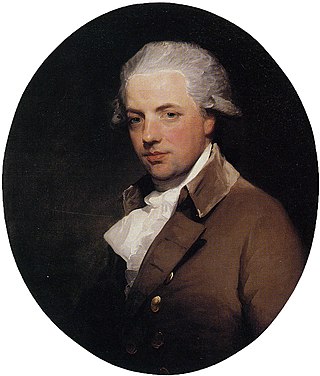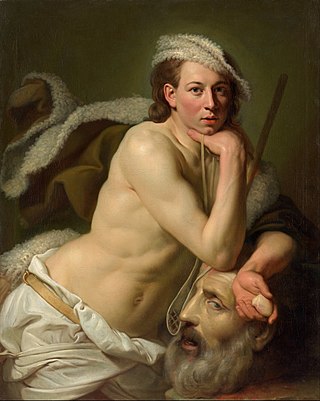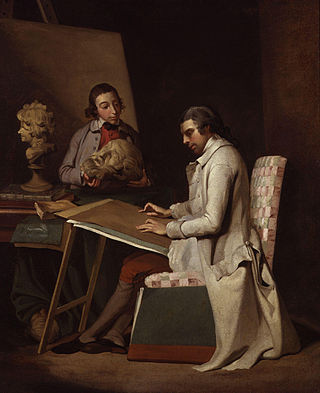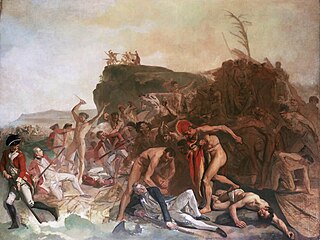
Fra Bartolomeo or Bartolommeo, also known as Bartolommeo di Pagholo, Bartolommeo di San Marco, Paolo di Jacopo del Fattorino, and his original nickname Baccio della Porta, was an Italian Renaissance painter of religious subjects. He spent all his career in Florence until his mid-forties, when he travelled to work in various cities, as far south as Rome. He trained with Cosimo Rosselli and in the 1490s fell under the influence of Savonarola, which led him to become a Dominican friar in 1500, renouncing painting for several years. Typically his paintings are of static groups of figures in subjects such as the Virgin and Child with Saints.

Horatio Walpole, 4th Earl of Orford, better known as Horace Walpole, was an English writer, art historian, man of letters, antiquarian, and Whig politician.

The Uffizi Gallery is a prominent art museum located adjacent to the Piazza della Signoria in the Historic Centre of Florence in the region of Tuscany, Italy. One of the most important Italian museums and the most visited, it is also one of the largest and best-known in the world and holds a collection of priceless works, particularly from the period of the Italian Renaissance.

Giovanni Battista Moroni was an Italian painter of the Mannerism. He also is called Giambattista Moroni. Best known for his elegantly realistic portraits of the local nobility and clergy, he is considered one of the great portrait painters of the Cinquecento.

Ozias Humphry was a leading English painter of portrait miniatures, later oils and pastels, of the 18th century. He was elected to the Royal Academy in 1791, and in 1792 he was appointed Portrait Painter in Crayons to the King.

The Yale Center for British Art at Yale University in central New Haven, Connecticut, houses the largest and most comprehensive collection of British art outside the United Kingdom. The collection of paintings, sculpture, drawings, prints, rare books, and manuscripts reflects the development of British art and culture from the Elizabethan period onward.

Alessandro Albani was a Roman Catholic cardinal remembered as a leading collector of antiquities, dealer and art patron in Rome. He supported the art historian, Johann Joachim Winckelmann and commissioned paintings from Anton Raphael Mengs. As a cardinal he furthered the interests of the governments of Austria, Savoy and Britain against those of France and Spain; he was a noted jurist and papal administrator in his earlier career. Upon his death he was the last cardinal created by Pope Innocent XIII.

Johan / Johann Joseph Zoffany was a German neoclassical painter who was active mainly in England, Italy, and India. His works appear in many prominent British collections, including the National Gallery, the Tate Gallery and the Royal Collection, as well as institutions in continental Europe, India, the United States and Australia. His name is sometimes spelled Zoffani or Zauffelij.

The Tribuna of the Uffizi (1772–1778) by Johan Zoffany is a painting of the north-east section of the Tribuna room in the Uffizi in Florence, Italy. The painting is part of the United Kingdom's Royal Collection.

John Hamilton Mortimer was a British figure and landscape painter and printmaker, known for romantic paintings set in Italy, works depicting conversations, and works drawn in the 1770s portraying war scenes, similar to those of Salvator Rosa.[I]
John Astley was an English portrait painter and amateur architect, known for his "patronage among a vast circle of fashion" as well as a fortune acquired through marriage.

Sir Horace (Horatio) Mann, 1st Baronet KB, was a long-standing British resident and diplomat in Florence.

Colonel Mordaunt's Cock Match, sometimes called Colonel Mordaunt's Cock Fight, is a painting by the German British artist Johann Zoffany. It records British colonial life in the Indian court of Asaf-Ud-Dowlah. The painting was completed in February 1788, four years after the event it records. The painting is part of the Tate Gallery collection. A recent cleaning has revealed the original colours and made more apparent what appears to be an erection visible on the Nawab of Oudh, the central figure.

George Nassau Clavering-Cowper, 3rd Earl Cowper was an English peer who went on the Grand Tour as a young man, but actually emigrated. Despite becoming a member of parliament and later inheriting lands and the title of Earl Cowper in England, he remained in Italy. He amassed a valuable art collection and became a Prince of the Holy Roman Empire. He was a patron of the arts and science.

The Death of Captain James Cook, 14 February 1779 is an oil-on-canvas painting by the German British artist Johann Zoffany. The painting, which records the loss of the British explorer Captain James Cook, was made in around 1794 or 1795, some years after the death of Cook in Hawaii in 1779. Other paintings of the death of Cook were painted earlier. The Mahiole that was included in the painting of Cook's death by Zoffany is said to be the helmet given to Cook when he first landed in Hawaii.

Strawberry Hill House—often called simply Strawberry Hill—is a Gothic Revival villa that was built in Twickenham, London, by Horace Walpole (1717–1797) from 1749 onward. It is a typical example of the "Strawberry Hill Gothic" style of architecture, and it prefigured the nineteenth-century Gothic Revival.
The Lenthall pictures were a number of paintings owned by the Lenthall family and housed at Burford Priory. The collection was publicly commented on by art historians and tourists. It was largely dispersed in two sales in 1808 and 1833, although some works were retained by the family and sold in the late 20th century.

Felton Hervey was an aristocratic English politician from Bury St Edmunds in Suffolk, and a member of the British royal household. He took his son and daughter on a grand tour of Italy where he met Johann Zoffany and Pope Clement XIV.

John Tylney, 2nd Earl Tylney was an English aristocrat and member of parliament who moved to Italy after a homosexual scandal.

Palazzo Manetti is a 15th Century Italian palazzo, located at Via Santo Spirito 23 in Florence.

































